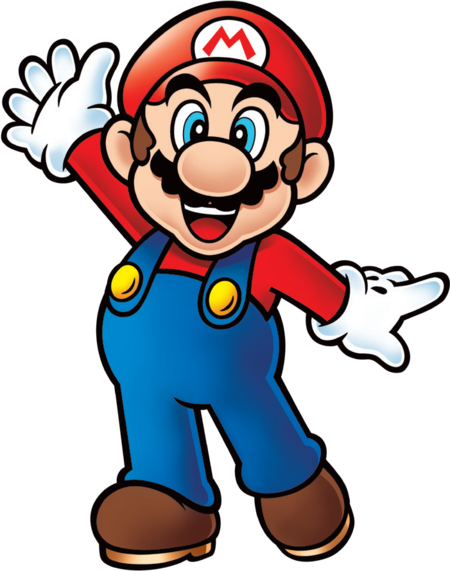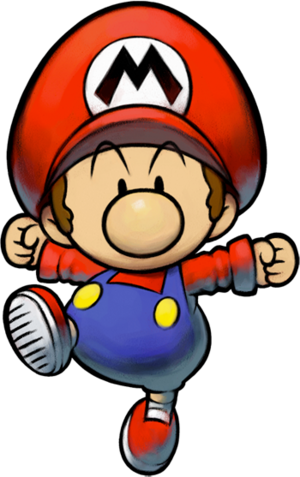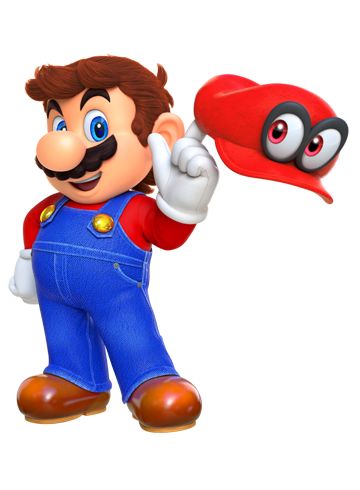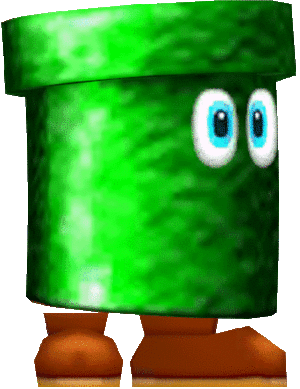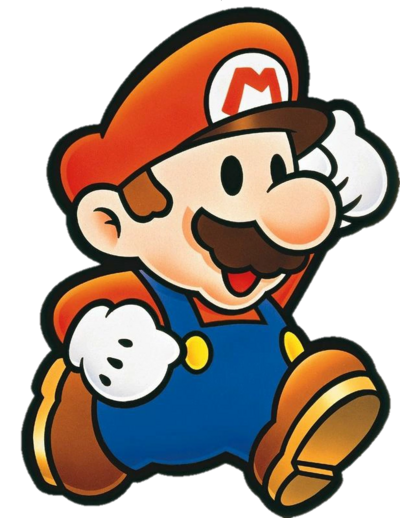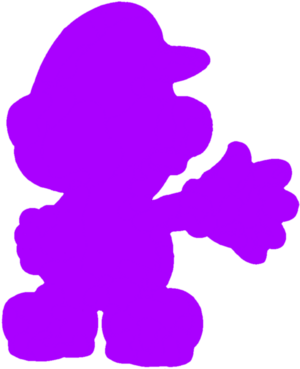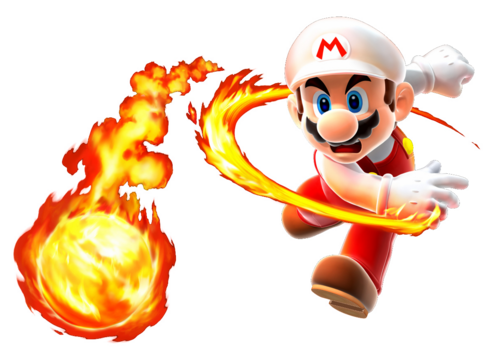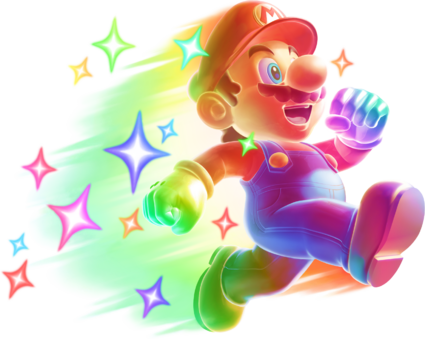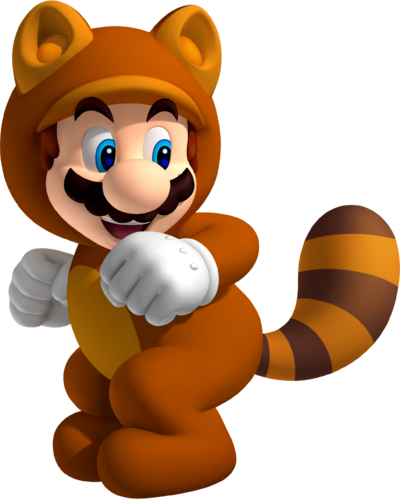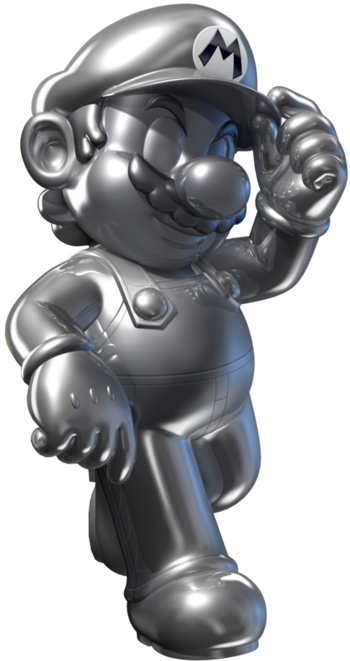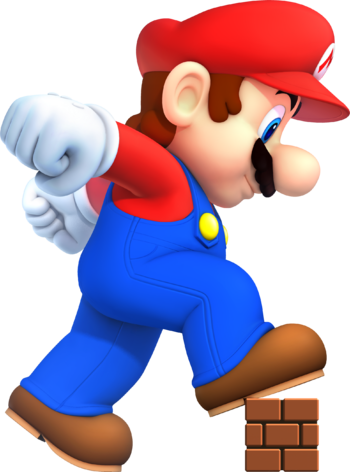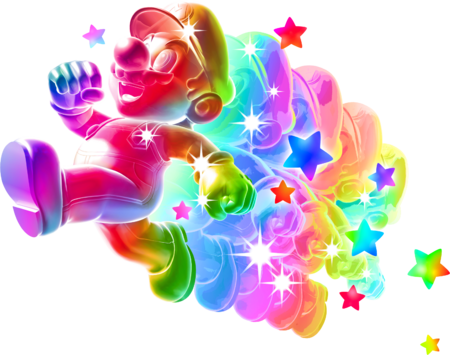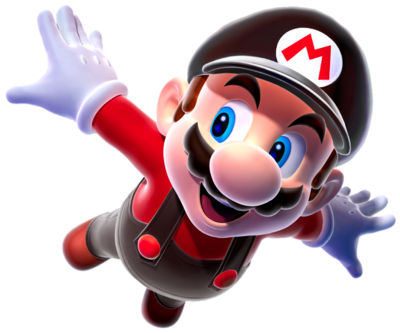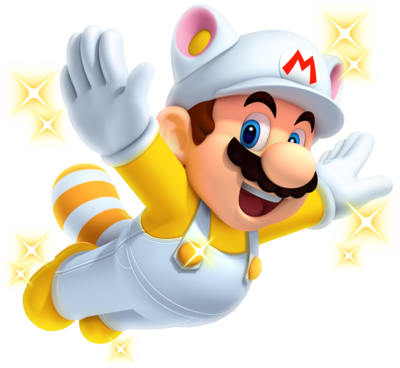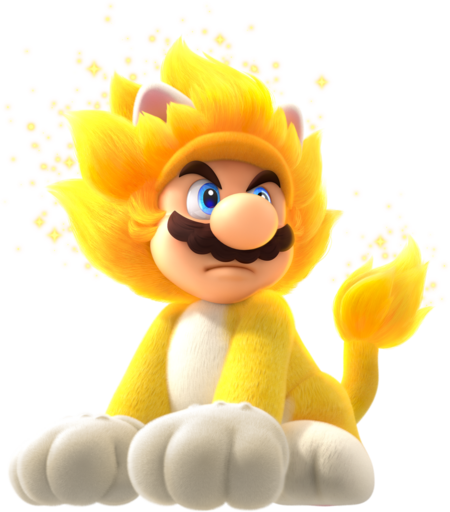|
Note: Credit to the Mario Wiki.
General information
Physical description
Mario's distinctive look is due to technology restrictions in the mid-1980s. With a limited number of pixels and colors, the game developers, including Mario's creator, Shigeru Miyamoto, could not animate Mario's movement without making his arms "disappear" if his shirt was a solid color, so they gave Mario overalls. The developers additionally did not have the space to give him a mouth, the result of Mario's mustache. Finally, they used a cap to bypass the problem of animating and drawing hair.
Mario has undergone major changes since his initial appearance in Donkey Kong up until Super Mario Bros. Although he has the general features such as the clothing and the mustache, it is not until Super Mario Bros. where he resembles as he is today. In Donkey Kong, Mario appears lankier with a more realistic-looking red nose and a cleft chin. In some portrayals in Donkey Kong Jr., however, he appears stouter with a round nose, which resembles more closely to Mario's current design, although some promotional art retains Mario's original Donkey Kong design. The stubbier design is retained in Mario Bros., with a few changes.
Since Super Mario Bros., however, Mario is depicted as a stocky young man who wears a trademark cap, a long-sleeved red shirt, blue overalls with two yellow buttons, brown shoes, and white gloves, with a large round face, a big round nose, clear and slightly tanned skin, chocolate brown hair (although the DiC cartoons sometimes depict it as black like his mustache) with three locks on the front, just above his forehead, four back locks that cover the back of his neck and a small sprout-like tuft on the top of his head, and a black mustache (sometimes brown like his hair). His neck is very short, to the point that both in artwork and in gameplay outside the Super Smash Bros. series, it is very rarely visible due to Mario's large head and the position of his chin. Though he was originally imagined as middle-aged, his age has been approximated to be about 26 years old, while Shigeru Miyamoto later placed it at either 24 or 25. The Mario vs. Wario comic also implies Mario (and Wario) is roughly in his late 20s or early 30s, as he recalls his childhood 20 years ago. Paper Mario: Color Splash also states that Mario has been fighting Bowser for 30 years, which he's first battled him as an infant.
While Mario is consistently portrayed as a short character, his precise height and proportions vary across media. An Amazon listing for a figure of Mario that is marketed as "life-size" lists its height as 150 cm (4 ft 11 in.) tall. Crossover artwork featuring Mario and Sonic the Hedgehog (who stands at 1 m / 3 ft 3 in.) shows Mario at around the same height as him, if not two or three inches shorter due to Sonic's quills. Mario's height relationship with other humans has been varied. Some media, such as Super Mario Odyssey and Mario's Time Machine, show Mario as much shorter than a realistic human, while others, including Mario Golf and the DIC cartoons, show Mario's height closer relative to other humans. The director of Super Mario Odyssey, Kenta Motokura, stated in an interview that New Donk City was realistic to showcase the extent of Mario's abilities in a realistic environment for a scale that is easy to understand, while Shigeru Miyamoto referred to the humans of New Donk City as "normal people". As far as in-game information or other official materials are concerned, Mario does not have a specified height.
Merchandise for the original Donkey Kong showed Mario as balding, although most media depict Mario with a full set of hair. The most notable change Mario has received over the years since Super Mario Bros. (omitting stylistic variations such as depictions in Paper Mario) is his change in stature; Mario is shown to be much stubbier in his earlier appearances compared to his more recent appearances, starting with Super Mario 64. Mario's legs and arms have grown longer over the years, giving him a slimmer look. This may have been the result of Shigeru Miyamoto's response to their "cute" appearances, who considered redesigning them to "become a bit more grown-up" in the GameCube era—for instance, by removing their trademark V-sign.
Mario from his Super Mario 64 appearance is depicted with darker blue overalls and bigger eyes than in his current appearance based on the one in Luigi's Mansion. He has a slightly darker skin, and his ears are also rounder. His overall straps are longer, and his cap is less round. Mario is overall less defined in the game artworks of the time due to the older software used to design him, especially noticeable in his hair, which appears reddish instead of chocolate brown and with a similar shape of his hat. The differences in Mario's 3D art over time, as a result, is more pronounced than the differences in Mario's 2D art since Super Mario Bros. Ever since Luigi's Mansion, however, Mario has received only minor changes to his general appearance, such as longer limbs, an increased height, a clearer and slightly tanned skin tone, brighter colors, and added detail in his shoes, eyes, and cap emblem in most game artworks since Super Mario 3D World, though in the Wii U and Switch generations, Mario's irises have been slightly thicker.
Mario has a few stylistic variations across some games, sometimes within series. One variation is Mario's overall appearance in the Paper Mario games: it is generally the same, with black dots for eyes and no eyebrows, although he has a shorter stature. Since Paper Mario: The Thousand-Year Door, however, Mario's body is more simplistic, with legless feet, a rounder face, and a full outline around the arms. In addition, starting with Paper Mario: Sticker Star, all of Mario's paper appearances have depicted him with a white outline around his entire body. Another variation is Mario's depiction in the Mario & Luigi games, although it is more subtle, where Mario is given black eyes rather than blue.
The Super Smash Bros. series also has Mario's appearance change between games. In Super Smash Bros. for Nintendo 64, Mario's appearance is derived from Super Mario 64 but with minor alterations, such as a slimmer appearance. In Super Smash Bros. Melee, Mario's design incorporates elements from Mario Kart 64 and Super Mario World, as well as official artwork from the Nintendo 64 era, which is evidenced by his tanned complexion. Mario's hair and clothing have more detail in them, with his overalls particularly sporting back pockets and having denim textures, similar to his sprite in Super Mario World. In Super Smash Bros. Brawl, Mario's back pockets return, but his overall design is updated to resemble his appearances in Super Mario Sunshine and later games. However, Mario's color scheme is darker than before, while his hair and clothing have more-realistic detailing. In Super Smash Bros. for Nintendo 3DS / Wii U, Mario's design is slimmer and more vibrant, matching his appearances in games like Super Mario 3D Land, Mario Kart 7, Super Mario 3D World, and Mario Kart 8. As an accompaniment, Mario's hair and clothing have much less detailing. In Super Smash Bros. Ultimate, Mario's design is mostly the same, aside from a more subdued color scheme and simple detailing in his hair and clothing, but not to the same extent as Melee and Brawl.
Clothing
Mario is typically shown wearing his trademark outfit wherever he goes. He has a long-sleeved red shirt (short-sleeved in Super Mario Sunshine), which is tucked under a pair of white gloves and has a noticeable collar at the neck. Layered over the shirt is a pair of blue overalls with yellow buttons. On his feet is a pair of light brown work shoes. In the Paper Mario series, these are known as boots and it is shown to have a rim on the top, although Mario's shoes in most media do not have this rim.
Originally, Mario wore red overalls on top of a blue shirt—nearly the opposite colors of what he wears now. The Famicom version of Mario Bros. is the first game to depict Mario with blue overalls and a red undershirt (although on the box art, he is depicted entirely in blue), but Super Mario Bros. 2 standardized Mario's current colors.
Mario's trademark is his red cap with his red "M" insignia. Mario's cap is sometimes an important and even mandatory accessory in some games, such as Super Mario 64, where he takes more damage without his cap. In Super Mario Sunshine, if Mario loses his cap, he acquires damage over time from the heat of the sun. In most media, however, Mario's cap is treated as a mere accessory, and Mario can go capless in some games without any additional effect, such as in New Super Mario Bros. Wii after obtaining 99 lives. In some games, such as Super Mario 3D Land, if Mario is in small form, he is seen without his cap, although it is no different from the other incarnations of the small form. In Super Mario Odyssey, Mario's default cap is replaced with Cappy, which can be replaced with other hats in the Crazy Cap stores as well. Additionally, Mario has over 40 outfits available to wear, which can range from recolors to resemble Luigi, Wario, or Waluigi to unique outfits that see Mario dressed as a pirate, astronaut, knight, or musician, or even naked with only his hat and a pair of polka dot boxers. In Mario & Sonic at the Olympic Games Tokyo 2020, Mario wears different outfits depending on the sport or activity being played.
Mario has seen some variations to his outfit in the games. In Super Mario Sunshine, for instance, Mario has shorter sleeves. In addition, Mario can wear a tropical shirt over his normal shirt, along with sunglasses that darken the screen, if he talks to the Sunglasses vendor. Mario also usually gains alternate outfits when using power-ups, from simple recolors to covering his whole body, such as Fire Mario, Tanooki Mario, Propeller Mario]], Flying Squirrel Mario, and Cat Mario. Finally, Mario can resemble different characters, even outside the Mario series, by using a Mystery Mushroom to change into one of the various forms of Costume Mario in Super Mario Maker. He even has a pumpkin Halloween costume that has him in his normal outfit, but with a pumpkin head he can put his head into, along with a purple cape.
Although mostly seen with his default plumber attire, Mario has also worn several alternate outfits in the spin-off games, including but not limited to Dr. Mario, NES Open Tournament Golf, Mario's Picross the Mario Strikers games, and Mario & Sonic at the Olympic Games Tokyo 2020.
Within the Super Smash Bros. series, Mario has a total of eight different costumes to choose from in battle (five in the original Super Smash Bros. and Super Smash Bros. Melee, six in Super Smash Bros. Brawl, and eight in Super Smash Bros. for 3DS / Wii U and Super Smash Bros. Ultimate). Mario's first alternate costume consists of red overalls and a blue cap and undershirt, being a reversal of his current color scheme, which was previously used in the DIC Entertainment Mario cartoons. Mario's second alternate costume consists of tiger-orange overalls and a green cap and undershirt, resembling his appearance on the Japanese box art for Wrecking Crew, as well as Luigi's in-game appearance from the arcade version of Mario Bros. (but with swapped colors). Mario's third alternate costume consists of brown overalls and cap, with a white undershirt, being inspired by Foreman Spike. Mario's fourth alternate costume consists of purple overalls and a yellow undershirt and cap, being derived from Wario's appearance. In Brawl, Mario gains a fifth alternate costume in the form of red overalls and a white cap and undershirt, derived from Fire Mario's current colors. In 3DS / Wii U, Mario's reversed red and blue costume is replaced by one with a pink undershirt and cyan overalls and cap, derived from his appearance on the Japanese box art of Mario Bros.; he also gains a costume with dark indigo overalls and a purple undershirt and cap, based on Waluigi; lastly, Mario gains a seventh alternate costume in the form of red-and-white striped overalls and cap, and a blue undershirt with white stars, based on his appearance in NES Open Tournament Golf. In Ultimate, Mario's Fire Mario and Wario costumes are replaced with his Builder and Wedding outfits from Super Mario Odyssey.
Name
Mario's family name is given as "Mario" in The Super Mario Bros. Super Show! live-action segments "Dance" and "Treasure of the Sierra Brooklyn" and made popular in the live-action Super Mario Bros. movie. This occasionally occurs in other media—for instance, the Prima guidebook for Mario Party 2 lists his name as Mario Mario in a note section, and the Prima guide for Mario & Luigi: Superstar Saga similarly shows Mario's full name as Mario Mario in the list of major characters. The arcade flyers for Donkey Kong/Donkey Kong Jr./Mario Bros. use the full name as well. Also, when people asked Mario (voiced by Charles Martinet) what his last name was at {San Diego Comic-Con 2012, he had responded with this: "What's my last name? Ah, that's a very good question! ...That's right! It's-a Mario. My name-a Mario Mario. Of course, my brother name, a-Luigi Mario. And of course, my mama's-a Mama Mia Mario; my papa Papa Pio Mario. Of course, my grandmama Grandmama Mia Mario, and my grandpapa Grandpa—et cetera, et cetera. Yeah, first name Mario, last name-a Mario. Yahoo!" However, Nintendo of America earlier claimed that "there are no last names." This was later stated by Nintendo president Satoru Iwata. Additionally, Shigeru Miyamoto has previously stated that Mario and Luigi do not have last names "just like Mickey Mouse" contrary to their depiction in the movie, although he has later redacted that stance, confirming at the Super Mario Bros. 30th Anniversary festival in September 2015 that Mario's and Luigi's last names are indeed "Mario."
Personality
Mario is known for being kind, cheerful, playful, courageous, and headstrong and is also eager and cocky in certain occasions. Officially, however, Nintendo producers have stated that Mario's biography is kept simple in order to make the character versatile and reusable in many different games and situations. In most media and some games, though, Mario is depicted as an Italian plumber from Brooklyn who stands for what is right and has a love for Italian food. Mario has proven himself to be a competent fighter, all-around sports player, and party lover in Mario spin-off titles.
Mario shows generally good sportsmanship, even complimenting his opponents, as shown in instances like Mario Kart 8 and Fortune Street, as well as smiling if he loses in Super Smash Bros. Ultimate. However, in other spin-offs, he is usually sad after a loss and sometimes sobs. For example, in Mario Kart 64, if he does not place on the podium, he is shown wiping a tear. In Mario Golf: Toadstool Tour, if he attains a Double Bogey, he throws a small fit. It has been said that Mario loves animals, especially the most unusual ones, and he also enjoys music, particularly opera or new-wave Europop, although there is no further comment for these statements. Mario Strikers Charged gives Mario a rock-n'-roll theme for his entrance and scoring animations and an orchestrated theme for his Super Ability. Finally, game art and gameplay depict Mario playing the saxophone, piano, guitar, synthesizer, timpani, xylophone, and trumpet. Mario is also said to be an avid listener. All Night Nippon Super Mario Bros. instruction booklet, pages 6 and 7.
Mario has been shown on various occasions to have an almost overbearing attitude towards his brother, as displayed by certain cutscenes in Mario Power Tennis; this is shown most often in Super Mario-kun. However, this could also just be Mario's outgoing "big brother" personality interacting with Luigi's more introverted nature. Additionally, Mario is much more impulsive and aggressive than his brother, Luigi, and is willing to enter dangerous situations all alone. In Super Mario RPG: Legend of the Seven Stars, Mallow even had to physically restrain Mario from brawling several times, such as before the battle with Bowyer, so that the heroes could figure out what exactly was happening to their world.
Mario has occasionally shown aggressive or vulgar tendencies throughout his appearances, albeit in a lighthearted and comic-relief manner; a notable exception is in Super Mario Momotarō, when Mario is shown holding a gun and aiming at Bowser, albeit to intimidate him. In Super Mario-kun, Mario is short-tempered and resorts to yelling at his friends for failing or taking uncalled-for actions; Mario himself is not above certain vulgar actions, such as farting to taunt his opponents or urinating on Yoshi, and he also cross-dresses several times, though these actions are not restricted to Mario. The title itself and the art style of the Super Mario-kun manga also depict Mario with a childish personality. "Kun" is a generally masculine Japanese honorific for juniors such as boys or teenagers.
In a virtual magazine for the Japan-exclusive Satellaview, his vulgar and aggressive tendencies are exaggerated for the purpose of adult-oriented humor. Mario is shown smoking a cigarette and abusing his friends and love interest; he abuses Toad in particular often due to the latter's own perverse behavior in the magazine (or else for no reason at all), stomps on both Toad and Peach repeatedly for having oral sex behind Mario's back, and kills the former character with a gun.
Mario seems to have a fixation with food. This is most notably seen in the DiC cartoon trilogy, which may also be the origin of this trait, where Mario is almost constantly hungry and fascinated with Italian food (mostly pizza and pasta), typically wanting to stop Bowser's latest scheme simply so he can eat and going to nearly any length to do so. In fact, in the The Super Mario Bros. Super Show! episode "Koopenstein," when Princess Peach asked him if he ever thought about anything besides food, Mario, with pure honesty, replied, "What else is there?" As in Super Mario 64 and its remake, the original reason Mario came to the castle is that Peach was baking him a cake, which becomes a recurring trend in future games, such as Super Mario Galaxy 2 and New Super Mario Bros. Wii, although Mario, as well as his friends, has also fallen for false invitations to a big feast, shown in Mario Party DS. Mario also dreams of pasta when he falls asleep in Super Mario 64, in Super Mario Odyssey, and in the Game Over screen of Mario vs. Donkey Kong. In the opening of Super Mario Sunshine, Mario is apparently daydreaming about seafood. In Fortune Street, he offers Yoshi to help by finding Yoshi's cookies but before playfully saying, "Just give me a second to brush these cookie crumbs out of my mustache!" Quite a few characters in other games also advised Mario to refrain from eating much. For instance, when Mario holds on to Hoot for too long, Hoot may complain about Mario's eating habits before getting exhausted and letting him go. Additionally, the Star Temple gate from Mario & Luigi: Partners in Time, while praising Mario for his pure heart, has criticized his diet, advising him to limit the Alfredo sauce and carbonara in tandem with more exercising.
Speech
Like many other protagonists of Nintendo games, Mario rarely speaks, his dialogue being primarily limited to numerous grunts and yells, making him a mostly semi-silent protagonist. When he does speak, he speaks English, sometimes broken, with a heavy Italian accent, often referring to himself in the third person. With Charles Martinet as his most recurring voice actor, Mario's voice is soft and high-pitched, but in a few other games and in the cartoons, Mario has a gruff voice usually associated with a Brooklyn accent. In the Mario vs. Donkey Kong titles, Mario speaks fully, shouting sentences such as "Come back here, you big monkey!" He can be clearly heard shouting, "Welcome! Welcome, new galaxy!" in the ending of Super Mario Galaxy, as well as saying, "Thank you so much for playing my game!" after the credits of several games. Mario has also been given full dialogue in Itadaki Street DS and Fortune Street. Despite Nintendo's emphasis on Mario as a silent protagonist, Mario is the most often heard speaking in full sentences, if occurrences outside the games (especially in special events in real life) are counted.
Likewise, in some cases, Mario is a true silent protagonist, or he does not speak in English. In Super Mario RPG: Legend of the Seven Stars, Mario is completely silent, communicating solely through pantomime. In the Paper Mario titles, he mainly communicates through simple nodding and hand gestures; while he is completely silent in Paper Mario, however, he is given grunts in the latter games. Mario is also silent during dialogue scenes in the Mario Baseball and Mario & Sonic series, although he can technically talk. In the Mario & Luigi titles, he and Luigi speak in unintelligible gibberish that the other characters can understand. In Super Mario Sunshine, Mario is "heard" speaking in the opening scenes, but his dialogue is completely inaudible, although this is present only in the American version of the game, while in the Japanese version, Mario is heard speaking coherently, such as saying, "Looks like Mario's gonna have to find a job!" to Toadsworth after landing on the Delfino Airstrip, although he still speaks more than in most games in the series.
He has full speech capabilities demonstrated in some sports titles and other games (including when being portrayed in real life), and he also speaks regularly in such mediums like the DiC cartoon trilogy, though he speaks perfect English with a Brooklyn accent in the latter. Mario has been shown to be able to speak in full sentences in promotional videos, such as a press conference released for Mario Sports Mix. Also, people can communicate with Mario by asking various questions; there, too, Mario can fully speak, although his Italian accent mostly disappears. In the games, other characters speak for him, mainly Lakitu and Toad.
|
